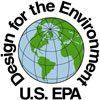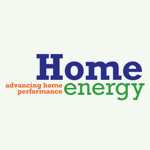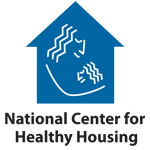EPA allows safer products to carry the Design for the Environment (DfE) label. This mark allows consumers to quickly identify and choose products that can help protect the environment and are safer for families.
We do not strictly control Google ad content. If you believe any Google ad is inappropriate, please email us directly here.
Product manufacturers who become DfE partners, and earn the right to display the DfE logo on recognized products, have invested heavily in research, development and reformulation, to ensure that their ingredients and finished product line up on the green end of the health and environmental spectrum, while maintaining or improving product performance.
EPA's Design for the Environment Program (DfE) has allowed use of the logo on hundreds of products. These products are formulated from safer ingredients and, in 2007, reduced the use of "chemicals of concern" by 80 million pounds, up from 59 million pounds in 2006.
This is how DfE makes sure that products bearing the label are really safer:
DfE carefully looks at each product ingredient - there are no exceptions.
DfE starts with information that scientists already know about each ingredient such as how it works in a detergent, and how it affects living things. Where that information doesn't tell the full story, EPA looks at an ingredient's chemical structure - its components and shape - to understand how it could impact the environment and people. A chemical's structure can tell a lot about how the chemical will behave and what types of effects it may have when it comes in contact with people or the environment. DfE uses the special skills of the scientists at EPA who have studied chemicals for 30 years or even longer.
DfE only allows use of the logo when a product is best in its class. DfE compares an ingredient's characteristics to other chemicals in the same class. That is, solvents are compared to other solvents, and wetting agents (surfactants) are compared with other surfactants. Before DfE allows the logo on a product, DfE makes sure that only the safest ingredients from each class are used.
If you would like a little more (technical) information, please read on:
When the DfE logo appears on a product, it means that the DfE review team has screened each ingredient in the product for potential human health and environmental effects and that - based on hazard and risk information, the latest models and predictive tools, and expert scientific judgment - the product contains only those ingredients that are the safest in their class. For example, if a DfE-recognized product contains a surfactant, then that surfactant will not be toxic to human health and it will biodegrade readily to non-polluting degradation products; many surfactants in conventional products biodegrade slowly or biodegrade to more toxic and persistent chemicals, which threaten aquatic life.
The DfE Program is unique because of two defining characteristics: its assessment methodology and its technical review team. The DfE technical review team has many years of experience and is highly skilled at assessing chemical hazards, applying predictive tools, and identifying safer substitutes for chemicals of concern. The review team applies the DfE assessment methodology by carefully reviewing every product ingredient (The review includes all chemicals, including those in proprietary raw material blends, which manufacturers share with DfE in confidentiality).
DfE uncovers chemicals of concern that can be masked by raw material blends or by dilution in water. By focusing at the ingredient level and on inherent characteristics, DfE is able to carefully scrutinize formulations and make meaningful calls on potential concerns. For example, a surfactant that is acutely toxic to aquatic organisms and environmentally persistent can appear to pose a low concern when blended with other less toxic and less persistent surfactants. Similarly, water, typically the largest percentage ingredient even in concentrates, can mask the toxicity of a hazardous chemical.
DfE spots negative synergies between product components. These potentially dangerous chemical combinations, which occur with surprising frequency in cleaning products, pose concerns for both acute and longer-term effects. For example, mixing nitrogen-containing compounds with amines will create nitrosamines, potent carcinogens.
DfE screens all fragrances and dyes for chemicals that may present serious health or environmental effects.
Some of the chemicals of most potential concern in cleaning products are those used in small concentrations. Chemicals of concern include sensitizers, carcinogens, and environmentally toxic and persistent compounds. Small quantities don't necessarily mean small hazards: A person, once sensitized to a chemical, can have an allergic response even if exposed at minute levels.
DfE recommends safer substitutes for chemicals of concern.
Sustainability requires innovation and continuous improvement. The DfE program works directly with EPA's Green Chemistry specialists to identify and recommend safer chemicals to its formulator partners, continuously raising the bar and redefining the meaning of environmentally preferable products. DfE helps product manufacturers by educating them and guiding them toward the development of safer products. This is a win for industry, families and the environment.
HHI Error Correction Policy
HHI is committed to accuracy of content and correcting information that is incomplete or inaccurate. With our broad scope of coverage of healthful indoor environments, and desire to rapidly publish info to benefit the community, mistakes are inevitable. HHI has established an error correction policy to welcome corrections or enhancements to our information. Please help us improve the quality of our content by contacting allen@healthyhouseinstitute.com with corrections or suggestions for improvement. Each contact will receive a respectful reply.
The Healthy House Institute (HHI), a for-profit educational LLC, provides the information on HealthyHouseInstitute.com as a free service to the public. The intent is to disseminate accurate, verified and science-based information on creating healthy home environments.
While an effort is made to ensure the quality of the content and credibility of sources listed on this site, HHI provides no warranty - expressed or implied - and assumes no legal liability for the accuracy, completeness, or usefulness of any information, product or process disclosed on or in conjunction with the site. The views and opinions of the authors or originators expressed herein do not necessarily state or reflect those of HHI: its principals, executives, Board members, advisors or affiliates.


 Safer cleaning products can help protect the environment and your family. When you use a cleaning product, it is released into the environment - inside your home and down the drain to the outdoors. Adults come in contact with cleaning products on a regular basis, as do children who are often the most exposed when they crawl on the floor. Some consumers may prefer cleaning products that, for example, are inherently safer or do not irritate sensitive skin. Others may prefer products that break down quickly and do not harm fish or are safer for use around family pets. The DfE logo is an easy way to know you are choosing a product that is safer for people and the environment.
Safer cleaning products can help protect the environment and your family. When you use a cleaning product, it is released into the environment - inside your home and down the drain to the outdoors. Adults come in contact with cleaning products on a regular basis, as do children who are often the most exposed when they crawl on the floor. Some consumers may prefer cleaning products that, for example, are inherently safer or do not irritate sensitive skin. Others may prefer products that break down quickly and do not harm fish or are safer for use around family pets. The DfE logo is an easy way to know you are choosing a product that is safer for people and the environment.





